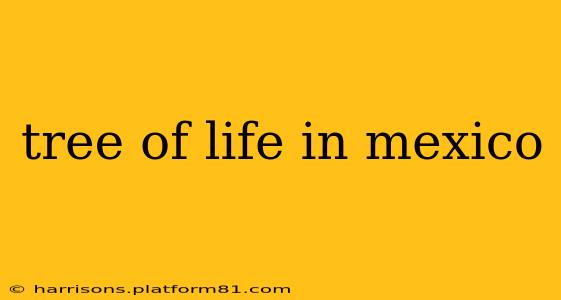Mexico, a land rich in history, culture, and biodiversity, boasts a fascinating array of symbolic imagery. Among the most potent and enduring is the "Árbol de la Vida," or Tree of Life. But what exactly is the Mexican Tree of Life, and what does it represent? This isn't just a singular tree species; it's a powerful artistic motif interwoven into the fabric of Mexican identity, reflecting its vibrant past and hopeful future.
What is the Mexican Tree of Life?
The Mexican Tree of Life is primarily known through its vibrant depictions in folk art. It's not a specific botanical species but rather a stylized representation, often a sprawling, richly detailed tree brimming with life. These artistic interpretations typically feature a central trunk from which numerous branches extend, laden with a profusion of animals, birds, flowers, and fruits. Each element holds symbolic meaning, often reflecting the diverse ecosystem of Mexico and its rich cultural heritage.
The artistic style varies regionally, showcasing the diversity of Mexican folk art traditions. Some depict the tree in a more fantastical, almost surreal manner, while others take a more realistic approach, reflecting specific flora and fauna from the artist's region.
What Does the Tree of Life Symbolize in Mexican Culture?
The symbolism of the Mexican Tree of Life is multifaceted, encompassing a variety of interpretations:
-
Connection to Nature: The abundance of plants and animals symbolizes humanity's interconnectedness with the natural world. It's a celebration of biodiversity and the beauty of the Mexican landscape.
-
Paradise and Abundance: The lushness of the tree, its bounty of fruits, and the vibrant creatures that inhabit it often represent paradise, abundance, and prosperity. It’s a visual metaphor for a life filled with richness and fulfillment.
-
Life, Death, and Renewal: The tree's cyclical nature – growth, flourishing, and eventual decay – often reflects the continuous cycle of life, death, and rebirth, a fundamental concept in many cultures, including Mexico's.
-
Family and Ancestry: The roots and branches, extending in all directions, can symbolize family lineage and the interconnectedness of generations.
-
Religious and Spiritual Symbolism: While not solely tied to a specific religion, the Tree of Life resonates with the spiritual beliefs of many Mexicans, representing connection to a higher power and the divine.
Where Can I Find Depictions of the Tree of Life?
The Mexican Tree of Life is widely visible throughout the country. You'll find it depicted in:
-
Folk Art: This is the most common place to encounter the Tree of Life, manifested in vibrant, hand-painted alebrijes (colorful folk art sculptures), pottery, textiles, and other crafts.
-
Religious Art: While not a strictly religious symbol, it can be incorporated into religious artwork, reflecting its symbolic power.
-
Modern Art: Contemporary Mexican artists continue to draw inspiration from this powerful motif, incorporating it into their creations in unique and innovative ways.
What are some variations of the Tree of Life in Mexican art?
The representation of the Tree of Life is not uniform across Mexico. Regional styles and personal interpretations contribute to its diversity. Some variations include:
-
Stylized vs. Realistic: Some artists opt for a highly stylized approach, focusing on symbolic elements rather than botanical accuracy. Others prefer a more realistic depiction of specific plants and animals from their region.
-
Color Palettes: The color choices often reflect the artist's style and the overall mood conveyed. Bright, vibrant hues represent joy and abundance, while more muted tones might suggest a sense of introspection or contemplation.
-
Incorporated Elements: The specific animals, plants, and other elements incorporated into the tree's composition vary greatly, reflecting the artist's personal experiences, beliefs, and observations of the surrounding world.
How is the Tree of Life relevant today?
Even in modern Mexico, the Tree of Life retains its significance as a powerful symbol of cultural heritage, resilience, and the interconnectedness of life. It's a reminder of the rich biodiversity of Mexico and the importance of preserving its natural resources. It also serves as a potent symbol of hope and renewal, resonating with the country's enduring spirit in the face of challenges.
The Mexican Tree of Life is far more than just a decorative motif. It's a profound symbol that encapsulates the nation's vibrant spirit and deep connection to its natural world and cultural heritage. Its continued relevance underscores its enduring power and enduring beauty.
